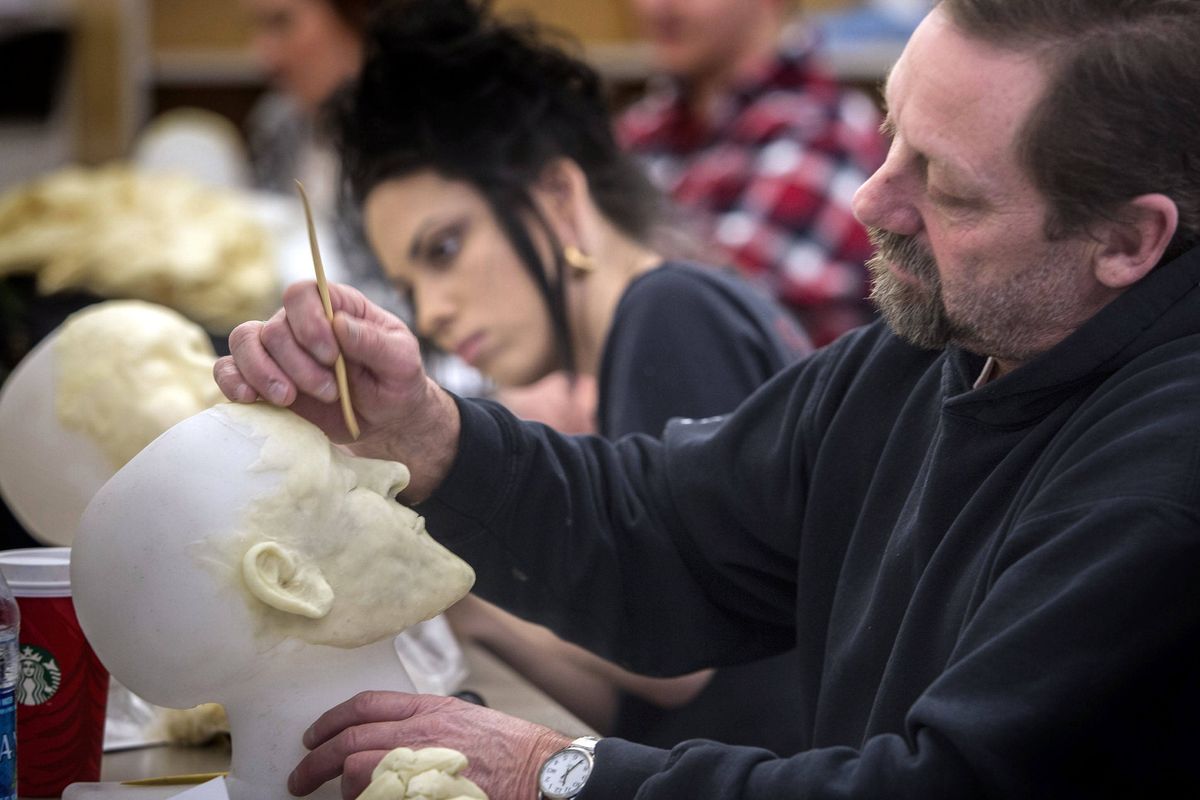Buried in studies
Future morticians learn tricks of trade

Here’s a question for Samantha Foster, 21, of Mukilteo, Washington, future mortician.
Why?
“I see dead people” is a great movie line, but as a full-time occupation?
She says, “There have been a lot of deaths in my family, but that only added to my intrigue. You’d think it’d be offsetting to see family members pass away, but I just got curious about how they got into that casket.”
As more and more of our aging population heads to that final frontier, it’ll be someone like Foster who’ll deal with the details.
Foster is an earnest, modern young woman, tattoos on her right arm, black hair piled high, nose piercing.
On this morning at the funeral- service class at Lake Washington Institute of Technology in Kirkland, Foster is molding soft mortician’s wax on a plastic-skull head.
She is doing a wax rendition of actor Bill Moseley, star of a number of cult horror films. “I thought it’d be appropriate, given the subject matter,” she says.
The two-year program – the only one in this state and one of the few on the West Coast – will graduate 22 students this year.
Instructor Craig Emmick says there still will be plenty of job opportunities because licensed funeral directors are needed in each of the 300 or so funeral homes in this state, and some 20,000 nationwide.
Foster explains about embalming: “Ever since I was a kid, I wanted to work in a medical field, but I didn’t want to deal with the possibility of someone dying under my care. This was something I could do, rebuild different features in the case of trauma.”
She’s originally from the Chicago area and plans to move back to the Midwest, where they do many more traditional funerals.
In Illinois, the cremation rate is in the 30 percent range, according to the Cremation Association of North America. Washington has the second-highest cremation rate in the country at nearly 73 percent. Nevada is highest.
Of the 22 students in the class, 14 are women. It used to be male-dominated.
One of the men, and one of the oldest students, in the class is Charlie Turner, 55. He moved here from Coeur d’Alene specifically to take the funeral classes, then plans to go back to Idaho. He says no such classes are offered in that state.
He used to be a house painter, until two failed knee surgeries. Of all the new career possibilities out there, he decided on embalming.
“I saw my first dead body when I was 5,” he says. “My grandmother used to have a nursing home, and one day, we found an old resident hanging from the rafters.”
And did that traumatize him?
“Not at all. In fact, every funeral I’ve been to, I’ve been amazed at how well prepared the body is,” says Turner.
He also points out a plus he has in studying embalming.
“I grew up in an upholstery shop, and started sewing when I was young. I always thought I’d do real good in sewing people up, and there is a lot of sewing involved in being an embalmer,” he says.
In this state, embalmers can expect to make $42,000 to $61,000 a year, and funeral directors $43,000 to $80,000, according to the Bureau of Labor Statistics.
On this day, some of the students will do actual embalming, but visitors can’t watch, out of respect for the deceased. But the students show some of the material used, like little oval plastic things with spikes. You put them on the eyeball and then close the eyelids on the spikes, as eyelids tend to sag back in dead people.
Emmick says that since the funeral director program began four years ago, 100 bodies have been donated for embalming. Two-thirds are indigents from various medical examiners. After that, another facility does the cremation.
Sometimes the students hold a memorial service for those they embalmed, in a room with a lectern and a display of caskets with price tags just like those found in a funeral home. It is a business that they’re going into, after all.
Recently, student Katey Houston, 24, said a few words in that room about an indigent veteran whom they had embalmed. Eight of the students then took his remains to Tahoma National Cemetery in Kent, Wash.
“I said, ‘I don’t claim to know anything of his life.’ I know it was likely hard,” says Houston. “I am thankful he gave to us twice, once in the military and once in death.”
A fellow student, Denton Thorbeck, 22, then booted up a “Amazing Grace” on his laptop.
The two have thought about how they’d like to go.
Thorbeck says that if it becomes legal in this state, as it has in some others, he’d like an alkaline hydrolysis cremation, in which the body is dissolved by lye. It’s supposed to be more “green.”
Houston says she wants to be cremated the old-fashioned way, in a furnace that can reach 1,800 degrees.
“It’s the only way I’m going to get a smokin’ hot body,” she says.
You gotta keep this death stuff in the right perspective.